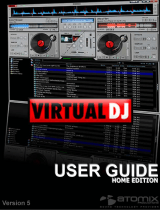
16/32– User Manual
5.4. Speeding up or slowing down a track
The main reason for speeding up or slowing down a track you are about to play is to match its
BPM (i.e. the number of beats per minute) and synchronize its beat with that of the track already
playing. In this way you can mix the two tracks together smoothly when switching from one deck
to another. There are two ways to regulate the speed of a track: by manually adjusting its pitch,
and automatically via beat-matching.
On vinyl decks, the pitch allows you to adjust the rotation speed of the turntable. This adjustment
therefore changes the speed of a track by modifying its overall tonality (for example, a track that
has been sped up significantly will sound much more high-pitched, or sharper).
You can therefore use one of the DJ Control MP3 e2’s Pitch knobs to modify the pitch of a track.
VirtualDJ also offers a very useful function to automatically match the BPM of tracks that are
playing and synchronize their beats for easy mixing: this function is called beat-matching. Press
the Sync button on either deck to toggle beat-matching on and off for the deck in question. When
the Sync button stays lit up in blue, beat-matching is enabled on that deck; when the LED is off,
beat-matching is disabled on that deck.
When a track is being played on a deck, the BPM is displayed just above the track’s timeline, to the right (the
percentage next to the BPM indicates how much faster (+x.x%) or slower (-x.x%) the current BPM is in relation
to the track’s normal BPM):
- Press the Sync button on a deck to automatically match the BPM and synchronize the beat of the track on
that deck with that of the track playing on the other deck.
The Sync button lights up. This track’s BPM is automatically matched to that of the track being played on the
other deck and their beats are synchronized.
- Make a transition from one track to the other (please see section
5.7. Switching from one track to another
If you decide to switch off beat-matching on this deck, press the Sync button again. The Sync button goes
dim, indicating that beat-matching is now switched off.
).
5.5. Creating cue points
Finished synchronizing the tempos of your tracks? Great – but depending on the tracks you are
using, you may wish to start up playback at a specific point and not simply at the beginning.
This is possible by inserting cue points into your tracks. A cue point allows you to locate the start
of an interesting rhythmic section and launch playback of a track at that section. VirtualDJ allows
you to set 1 cue point per track using your DJ Control MP3 e2




















